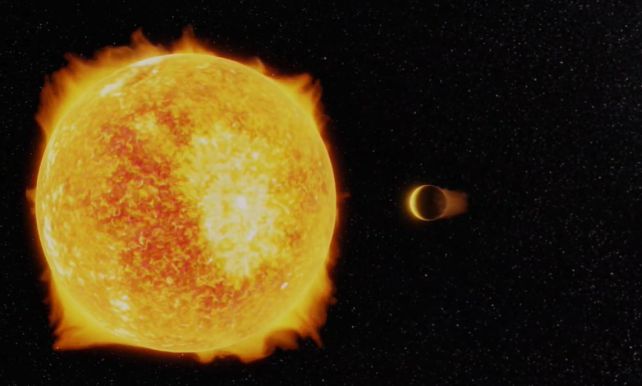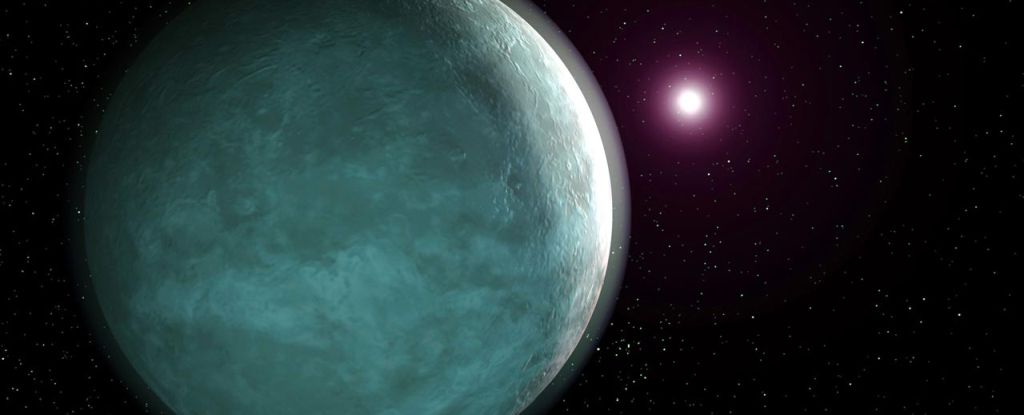Products You May Like
A newly discovered exoplanet has presented astronomers with an interesting problem.
It’s called TOI-332b, and its physical properties and orbital distance from its star are challenging to explain with current planetary formation theory. With so few exoplanets of its kind detected in the Milky Way so far, it could shed some light on why fast-orbiting, Neptune-sized worlds seem so scarce.
“We present here the detection and characterization of TOI-332b, an ultra-short period planet with an unusually high density located deep within the Neptunian desert,” write a team led by astrophysicist Ares Osborn of the University of Warwick in the UK in a preprint available on arXiv.
“TOI-332b is a very interesting addition to our current Neptunian desert discoveries and a case study to test planet formation theory.”
Humanity has discovered and confirmed more than 5,500 exoplanets to date (that’s extrasolar planets, worlds outside the Solar System), and we’re seeing some interesting patterns emerge.
Some exoplanet properties, such as radius or distance from their star, are relatively common; some, however, are much more scarce. Working out why we have found lots and lots of some types of worlds, and so few of others, could be a clue as to how planetary systems form and evolve.

One area of scarcity is known as the Neptunian desert. We have found bafflingly few exoplanets the size of Neptune orbiting closely with their stars. In fact, as Osborn and their colleagues point out, there is only a scant handful of exoplanets sitting square in the gap.
Newly discovered TOI-332b, orbiting an orange dwarf star 727 light-years away, fits squarely inside it. Measurements of the effects it has on its host star’s light reveal it has a radius 3.2 times that of Earth (Neptune is 3.88 Earth radii), and orbits the star once every 18.72 hours.
These properties alone would make TOI-332b an object of interest, but there’s something else. The gravitational effect on its host star has allowed Osborn and their team to measure the exoplanet’s mass. It clocks in at 57.2 Earth masses. Neptune is 17.15 Earth masses.
This means TOI-332b has a whopping density of 9.6 grams per cubic centimeter. That’s one of the densest Neptune exoplanet masses ever found. Neptune itself has a density of 1.64 grams per cubic centimeter. Earth’s is 5.51 grams. TOI-332b is, on average, denser than iron.
Modeling suggests that the exoplanet has a huge, dense iron core, with a rocky mantle and a thin atmosphere of hydrogen and helium. But for a core the size of the one inferred for TOI-332b, a large, thick, extended Jupiter-like atmosphere is expected.
Which raises the very interesting question: where did TOI-332b’s atmosphere go?

For a world that close to its star, photoevaporation processes – where the extreme radiation from the star causes the atmosphere to evaporate and leak away – should occur. But photoevaporation alone cannot account for the loss of an atmosphere that size. In fact, it cannot account for most of it.
Other processes include planetary migration, which would have seen the atmosphere stripped as the exoplanet moved from a greater distance in towards its host star, and subsequent heating from the inside due to gravitational changes in the exoplanet’s orbit.
It’s also possible a giant impact with another planet-sized object may have blasted off most of TOI-332b’s atmosphere. Or TOI-332b simply never accreted an atmosphere to start with.
Whatever the case, it’s going to take a closer look to figure out why TOI-332b is the way it is.
“This unusual planet tests what we currently understand about planet formation; how such a giant core exists without a gaseous envelope remains an unanswered question,” the researchers write.
“Further observations are needed to potentially disentangle TOI-332b’s formation history and current characteristics.”
The research has been accepted into the Monthly Notices of the Royal Astronomical Society, and is available on arXiv.
